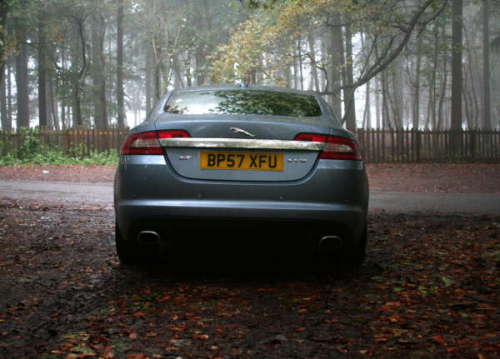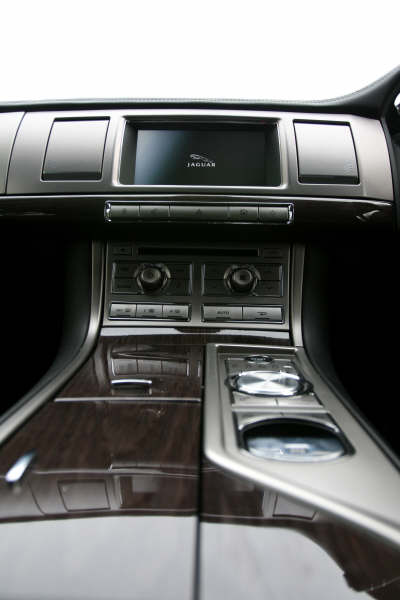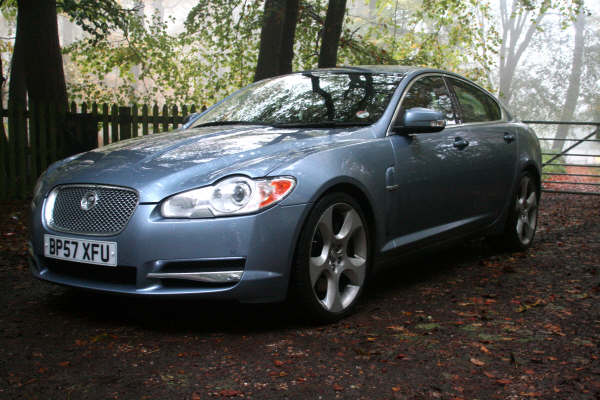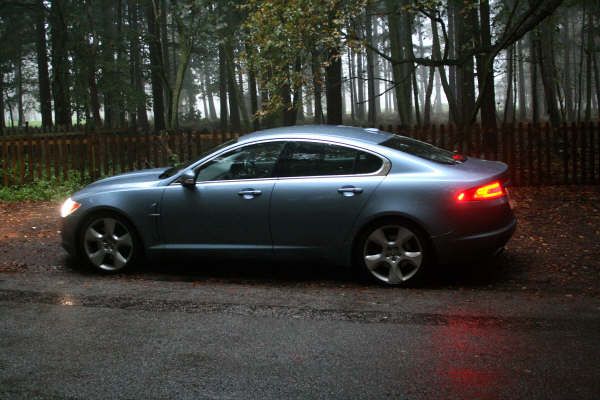A new Jaguar arrives none too often and its day of eventual delivery could only be described, as “an event” as James May often enunciates. It didn’t matter that one hack dinged the diesel XF (that I had reserved) in Scotland as it was replaced with the most expensive version, a £53,753 V8 twin-supercharger!
I reckon that Willy Lyons would have wept had he known that Tata Motors of India now owns the company but may have given a silent, appreciatory nod at the look of the new XF. The styling is relatively fresh, whilst retaining some walnut veneer and at last, the design team has had the confidence to break the mould of retro-designs which inhibited the XF’s predecessor, the S-type, and continues in my view to do so with the rest of the ‘range’, small as it is.

There are many visual cues here, from the taut Astonesque rear to the wide grille that reminds us of Jaguar’s racing heritage. The flare that fades from around the main headlight should remain but could be doubled to surround the foglight as this is a Jaguar gene, and the XF is no crossbreed. The bonnet is confused and incoherent, with too many lines which don’t marry well with the rest of the car’s “design language”; a contrast to Chris Bangle’s controversial ‘Flame’ design which adorns all BMW models and has proven, despite the initial scepticism to be highly profitable.
Jaguar’s aim, with those television adverts, is to attract a younger audience to break away from its predictable, staid image. It has worked, with Jaguar posting its first profit in over ten years as it was being sold, thanks to the XF.

Inside, a shiny steel centre console echoes 1950’s Detroit decadence and covers the rising, rotating gear control and electro-magnetic handbrake that eliminates any physical effort. Textured, metallic plating, similar to that found on my kitchen sink continues this theme on the dashboard and confirms that this is rungs up in quality and substance from the S-type. One gripe that I’ve had with Jaguar as a manufacturer is bonnet misalignment, from a 5mm rise my Boss’ XJ to uneven gaps around the clamshell bonnet of X-types that I’d tested. The XF heals this scar though, with only a slight difference in symmetry between the windscreen pillar’s spacings but I’m distracted from my examination by the pulsating hue of the start-stop button, emulating the rhythm of my increasing heartbeat.
I remember mistakenly mocking Russell Bray, motoring correspondent for the Daily Mail, for wearing a pair of blue racing shoes whilst testing at Castle Coombe as I realised that the rear wheels will squeal if you can’t feel the throttle pedal through your footwear. You have to dress for the occasion…as your head bolts back into the rest and the rev and speedometer needles dance in conjunction and then move independently, as you focus your glare on the road ahead to plan your line. I sought to explore the SV8 as it’s known, around Goyt Valley in the twilight of the Peak District on desolate, damp B-roads to find its limit as the superchargers whined to voice their fury. It reacts quicker than the old S-type R and is leashed using hints of throttle control and ‘covering the brake’, when my bravery evaded me. I drove this car and the only oil-burner available in the XF, the 2.7 diesel, which felt underpowered, at Millbrook proving ground, Bedfordshire and discovered the lack of feel of the wheels through the steering, especially on bendy roads with coarse surfaces. Obviously, the SV8 has tauter suspension that will absorb bounce on a rise but everything feels too light, especially up front, and whilst I didn’t experience any understeer, I didn’t feel that I could push through any harder without firstly making a sign of the cross. At around town, the steering adjusts so its heavier but you get the sensation of a weighty pendulum tied to its centre that tries to keep it there; I almost stopped the car to check whether one of the tyres had deflated, such was the feeling of numbness at low speeds. This is my main criticism, as this V8, that was used in the S-Type R is a great engine that suits the body of the XF perfectly. It’ll kick its leg out slightly exiting a roundabout on full acceleration from those rotor-type superchargers, driven by the crankshaft, which will pull you from 2000rpm and beyond up to a curtailed 155mph.

The infamous J-gate has been replaced by paddleshifts which were tried on the windies around Leek but I couldn’t replicate the refinement of six automatic gearchanges which rendered it obsolete to my attempts at least, besides, automatic mode will override if changes are too erratic. The function of that rotary control, or round knob to you and me depends on whether it will rise out of its hole. The gimmicky theme continues when you turn the dial to R and see what’s behind you via the Sat. Nav. screen that doubles as a reversing camera and becomes downright absurd when you touch a sensor to open the glovebox; I mean, gravity can do that! A journey via A-roads across to Derby and then south along the M1, towards what Bill Bailey referred to as “The Devil’s Lay-by”, that is Milton Keynes, reveals a clearer overall judgement of the SV8 as a long-distance performer. The Sat. Nav. is easier to read than previous models, but needs a secondary source, like the small redundant screen between the dials that could display basic information like directional arrows and distance countdowns to the next turn-off, a la Audi. Also, autowipers only work when autolamps are set and the leather seatbases stretched to show my cheek’s marks. A mixture of roads gave a range of mpg readings from the late teens to just under 23, 3 more than the old S-type R.

This car is a good ‘un and may elevate itself to brilliance if the suspension is adjusted; my colleague Russell Morley suspects that the settings are gauged for American roads, as the XK performed similarly. It’s difficult to pinpoint the problem though because it’s caused by either the tyres and/or the shock-absorbers that don’t translate their motion through the steering, and while we’re not comparing the SV8 to BMW levels of ride composure yet, we could do with some tweaks.
The XF can, like the XJ secure a niche. The latter is a proven fuel-efficient long-distance cruiser whilst the former can, with bigger diesel engines combine this with sporting ability or “Sporting Luxury” as Jaguar blurb dictates. Of course, this may happen with Tata’s support but Jaguar can’t progress significantly with the ageing engines that it has, let alone the archaic X-type that has been in production since 2001. Opening showrooms in the Far East is becoming a reality and Jaguar can secure a foothold, provided that it works towards a focussed goal to establish a gap in the market. I wish it good fortune so that we can celebrate another event such as this one.
February 2009
All words are copyright of Sotiris Vassiliou
Images are copyright of Melissa Sutcliffe

